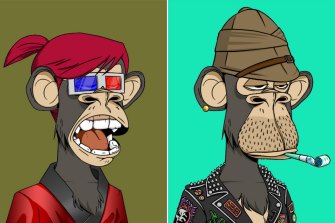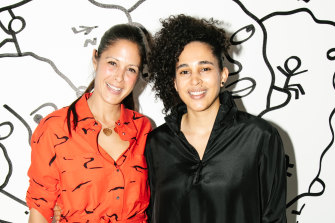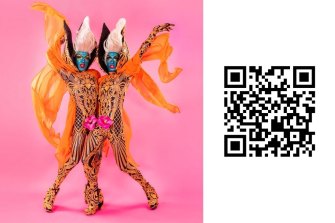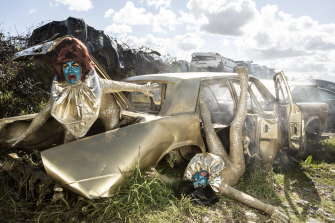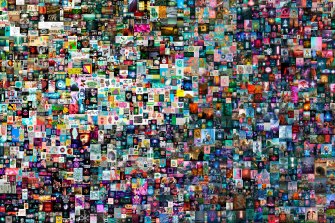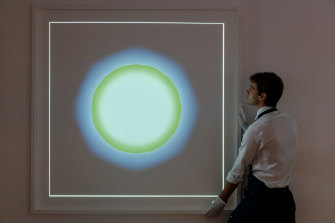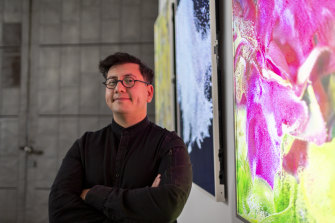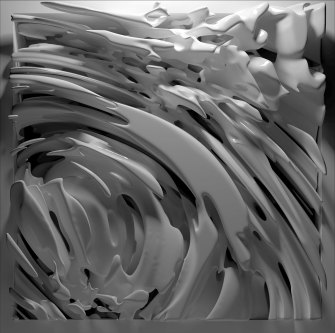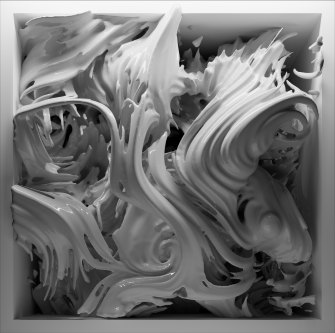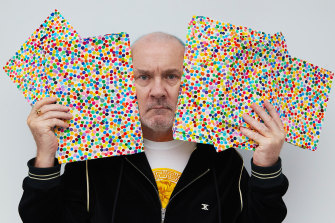By Gabriella Coslovich
xCredit:The Huxleys
In a world awash with acronyms, there’s one that has a particular power to make hackles rise, especially in the arts: NFT. Even spelled out – non-fungible token – it remains obscure, an unpoetic intruder from deep tech. Difficult to understand, difficult to access (unless you’re a so-called digital native), surrounded by jargon and hype, NFTs, for those who favour “real” art in the “real” world, are infinitely off-putting, a nuisance they hope will disappear. As one gallerist, speaking off the record, put it, “It has no f—ing relevance to art and it does my head in. The prices that are out there, it’s just such BS.”
That gallerist may well be experiencing a warm flush of schadenfreude now in light of the recent cryptocurrency crash. Amid the collapse, the backlash against cryptocurrencies – which some critics have labelled as nothing more than a Ponzi scheme – has been swift and severe. But does the crypto-crash signal the end of NFT “art”? That’s a wish that looks unlikely to be granted any time soon.
Popular Bored Ape Yacht Club NFTs now sell for millions of dollars each.
“We’ve actually seen an uptick in sales since the crash,” says Michelle Grey, the Sydney-based co-founder of Culture Vault. The online platform seeks to sell “high-quality” NFTs rather than the more insipid examples circulating: notably the “bored apes” the international celebrity set has taken up with glee, and which are more akin to nightclub medallions of old – offering exclusive membership – than anything resembling art.
Culture Vault is attempting to counter NFT scepticism by enlisting emerging and established artists, Australian and international, whose work has traction – among them Reko Rennie, the Huxleys, Romance Was Born, Stephen Ormandy and Shantell Martin. With the plunge in the value of cryptocurrencies, these artists’ NFTs have suddenly become more affordable in real dollar terms.
Michelle Grey (left) with artist Shantell Martin.Credit:Absolut Art
“It’s actually a really exciting time for NFTs now that the pricing bubble has burst,” Grey says. “We’re seeing artists who are genuinely interested in the space, rather than those just looking for a quick cash grab. If you value and truly appreciate digital art as a medium, the crash shouldn’t affect your predilection for NFTs. However, if you were only buying NFTs purely as an investment, and not because you love the art, then maybe the crash would make you less likely to continue collecting.”
It’s Grey’s job to talk up NFTs. But how do artists feel about the falling prices of their NFTs?
“We’ve been so busy making art that we didn’t know there was a crypto crash,” says Will Huxley, one half of the brilliantly creative duo the Huxleys, who have just finished performing at Melbourne’s recent Rising festival.
Will and his partner in life and art, Garrett, work across mediums; they make outlandishly beautiful costumes – frequently featuring sequins and glittery face paint – and pose in them in otherworldly landscapes and theatrical sets, producing photographs and videos. They also perform live. And they readily admit to not really understanding how NFTs work. They provide the art and leave the technical stuff to the experts at Culture Vault.
“We just thought, let’s give it a try because we love the arts and we love all art forms,” Will says. “We never made the NFTs thinking about the financial side of things. We kind of thought it could be a fun way to reach different audiences and to try something new. For most of our art-making career we’ve self-funded or just made art because we love it. It’s fantastic that we can do this full-time and make a living from it, especially in Australia where art isn’t valued nearly as much as it should be. But I think we would go on making art even if no one wanted to buy it.”
This work was created by The Huxleys as a special one off NFT for Spectrum. Hibiscus is a tribute to performance artist Hibiscus (1949-1982) a founding member of acid drag performance group The Cockettes. You can buy it as an NFT on Culture Vault by scanning the QR code (all profits to the artists).Credit:The Huxleys
A disclaimer: I own an artwork by the Huxleys, a real-life photograph called Nervous Wreck. It’s irresistibly, splendidly, camp, and features Will and Garrett in gaudy wigs, gold bodysuits, turquoise-painted faces, flamboyantly tumbling out of the smoking wreckage of a gold-painted vintage sedan. Culture Vault has minted a 30-second NFT video and soundscape of the same scene – kind of like the photo come to life. In May, that NFT cost $310 on Culture Vault. After the crypto crash, the price has dropped to $109.
Not that the Huxleys noticed.
“As we’ve been so busy making new work we didn’t check on the value of our NFTs,” Will says. “But we aren’t too worried about the crash as it’s not our main source of income and it’s not our main focus in making art. If anything, it’s nice for people who might be able to grab a bargain. It means it’s affordable for more people.”
Will’s attitude to art-making and art is infinitely generous. Still, I’d rather my $750 photograph than a bargain-priced NFT. I’m not even sure what I’d do with an NFT, and I tell Will, which he totally gets.
The Huxleys’ Nervous Wreck, avaliable in print and as an NFT.Credit:The Huxleys
“There’s something that is magical about a framed photograph or painting that will never be replaced by the NFT, but the thing that is nice about the NFT is that it offers an alternative, maybe a more affordable or acceptable way for people to experience having that artwork. I’m more like you; I would probably rather the framed photograph, but I love the idea that NFTs give another option.”
One of the debates in this field is whether an NFT can even be classified as a medium, in the same way as say painting, sculpture, photography or print-making. An NFT, is not, technically a medium. What it is, for those who need a refresher, is an immutable piece of data stored on a blockchain (a digital ledger).
“The medium that NFT artists use is generally referred to as digital art, but of course there are many other applications for NFTs beyond just digital art,” says Grey. “But because of the type of data that this token can carry – JPEGs, MP4s, videos and so on – it’s a great application for art because these files can be expressed as 2D or 3D animations, moving sculptural files, videos, pieces of music synced to dynamic images – it’s all about how creative the artists wants to get.”
So what do you do with an NFT of an artwork? You can display it on your smartphone, or on a screen at home, or show it in your own online gallery, and all of these things appeal, apparently, to a new breed of collectors. NFTs’ portability means that artists can reach new audiences and revenue streams. The Huxleys call NFTs their “sequin fund”, although they have yet to convert any of the cryptocurrency they’ve earned into real dollars.
“That will happen when our sequin fund gets too low and we need more money to make art,” Will says.
He adds, however, that the NFT marketplace doesn’t feel “overly tangible”.
“I don’t think we would ever rely on its stability as a platform. Technology moves so fast, but art remains constant. The art is what’s most important to us.”
Although NFTs can be traced back to 2014, the technology exploded into mainstream attention last year when an NFT featuring a collage of 5000 digital images by an artist most people had never heard of, Beeple, sold for US$69.3 million ($99.4 million) at a Christie’s online auction. That’s more than the auction record for a Raphael, a Titian, or a Turner – artists who have stood the test of time.
This NFT of a collage by artist Beeple sold for $US69.3 million.
The proponents of NFTs viewed the Beeple sale as an example of the technology’s power to democratise the arts and smash prevailing hierarchies. Sceptics saw it as a farce, proof of an inflated and unsustainable market – and they’re feeling vindicated. Others have yet to make up their minds and are exploring the technology for themselves, deciding whether NFTs are a fad, or an important new direction in art, and worth investing in – especially now. As Will Huxley puts it, quoting his physicist dad, “whatever goes up, must come down, and vice versa. It’s the law of physics”.
International art auction giants including Christie’s and Sotheby’s are selling NFTs by the virtual truckload. The technology has been hard to ignore. Christie’s sold about US$150 million worth of NFTs last year, while Sotheby’s traded nearly US$100 million worth. That’s a fraction of the billions these auction houses turn over each year, but in an Australian context, US$250 million is huge: almost triple the entire takings at art auctions in Australia last year. The NFT market here, though, is still in its infancy – not a single NFT has come up for sale at art auction in Australia.
One Australian auction house, however, recently announced that it would start accepting cryptocurrency. In an Australian first, Smith & Singer is taking cryptocurrency as payment for works in its current Brett Whiteley exhibition in Melbourne. Tellingly, Smith & Singer have no immediate plans to sell NFTs. Chief executive officer Gary Singer says the company is “a bit more old-fashioned when it comes to physical art” and isn’t sure that NFTs are a lasting thing.
Some well-established Australian artists are not exactly rushing to get in on the action either. When I try to contact Lindy Lee, who made headlines with her $14 million sculpture commission for the National Gallery of Australia, her dealer comes back to me and says that Lee “has nothing to say on the subject”, which in some ways speaks volumes.
Kevin McCoy’s Quantum (2014) – the first artwork ever minted – part of “Natively Digital: A Curated NFT Sale” at Sotheby’s in London last year.Credit:Getty
Another Australian artist, Danie Mellor, worries about NFTs’ environmental impact, as minting and trading NFTs is carbon-intensive.
Says Mellor: “At the moment I feel hesitant given the sheer volume and quantity of NFTs being sold, and some of the reasons they are being acquired, along with their energy footprint, so it can feel challenging.” He is open to working with NFTs “under the right circumstances and at the right time”.
So, what do NFTs offer “traditional” collectors that the current art market does not? That’s a question that long-standing Sydney art dealer Justin Miller is exploring.
“A great deal of the [NFT] market is aimed at the ‘crypto-bro’ consumer, and I was interested to look at how one might introduce more traditional art buyers into this space,” says Miller, who was chairman of Sotheby’s Australian arm for more than a decade.
Last year, Miller and his old school friend, venture capitalist Mark Carnegie, co-funded a philanthropic project involving eight Australian artists working in a range of mediums including bark painting, street art, drawing and watercolour. The project supported these artists to create new digital artworks that were minted as NFTs and auctioned, with all the money going back to the artists.
Miller found that the major weakness with NFTs is the complexity involved in buying them. People accustomed to going to a commercial gallery and buying art with cash or credit are put off by the many hoops they must jump through to buy an NFT. They need to organise a digital wallet, obtain cryptocurrency, transfer that cryptocurrency into their digital wallet, link their digital wallet to an NFT marketplace, create a user account with the NFT marketplace, use their cryptocurrency to purchase the NFT. A lot of people give up halfway through.
Refik Anadol in his California studio. Credit:Lauren Crew
“Sure it has its problems, any technology in its infancy does, but those problems will be sorted,” Miller says. “You have to think ahead and think about future consumers. In future, a lot of collectors will collect online, they will display their artworks online, they’ll have homes online, they’ll have avatars online, their lives will be spent very much more online than ours are.”
If that sounds terribly dispiriting, you’re probably from a time when cultural objects were things you could touch, handle, store on a shelf, hang on a wall, play on a turntable, and physically lend and borrow. A generational divide appears at play when it comes to NFTs. Just look at the sale of Beeple’s now-famous artwork Everydays: The First 5000 Days. As reported in The Art Newspaper, 58 per cent of bids for the work were placed by Millennials.
Refik Anadol, Quantum Memories: Noise A, purchased as an NFT by the NGV.
What do Australia’s public art institutions make of NFTs? The National Gallery of Australia, which has been at the forefront of responding to gender-related issues, has yet to form a position. The Art Gallery of NSW is watching developments and discussing NFTs with artists and museum colleagues around the world
“Decisions about NFTs for our state collection will be made with many considerations in mind including artistic merit, longevity, sustainability and conservation,” says AGNSW deputy director and director of collections Maud Page.
The Australian Centre for the Moving Image in Melbourne, which has a long history of acquiring digital art and supporting digital artists, is interested in some of the artists who are exploring NFTs as a sales mechanism but does not have a current plan to purchase NFTs.
Refik Anadol’s Quantum Memories: Noise B.
The National Gallery of Victoria, though, has dipped its toe in the water as part of its “responsive collecting” policy. The gallery has acquired three NFTs from Turkish-born media artist Refik Anadol’s Quantum Memories: Noise, and two NFTs from British artist Damien Hirst’s The Currency.
Hirst’s much-publicised Currency project comprises 10,000 small dot paintings (on A4 size paper) and 10,000 NFTs that correspond to each of those paintings. The NFTs were initially offered for sale on the Heni online marketplace and successful buyers ultimately have to decide whether they want to keep their NFT or the corresponding physical painting. Whichever they choose (NFT or painting), Hirst will destroy the other. The NGV has bought two of Hirst’s NFTs so that it can keep an example of both the NFT and the physical painting.
“We plan to display the physical painting alongside the digital artwork, which I think is a really fascinating way of approaching NFTs as a conversation about art,” says the NGV’s assistant director, curatorial and audience engagement, Donna McColm.
Damien Hurst with The Currency.
The Currency cuts to the core of the NFT quandary – where is the line between art and currency, currency and art? What matters more to you, the digital or the physical? And what, ultimately, will be worth more, not just in monetary terms, but culturally?
Will we be sighing in front of an NFT in a hundred years’ time as we do before Leonardo da Vinci’s Mona Lisa, van Gogh’s Sunflowers, or Emily Kame Kngwarreye’s Big Yam Dreaming? Or will NFTs have passed into the shallow grave of obsolete technologies, like VHS and Beta?
“I would be a ridiculous person if I told you I could guarantee anything in the NFT space,” says Grey. “Experiencing something in an early adoptive phase is very exciting, and if you’re doing it because you want some huge payout in 20 years and you want a guarantee, I’m not sure that anybody could give that … but like anything in life, the bigger the risk, the greater the return.”
A cultural guide to going out and loving your city. Sign up to our Culture Fix newsletter here.
Most Viewed in Culture
Source: Read Full Article
